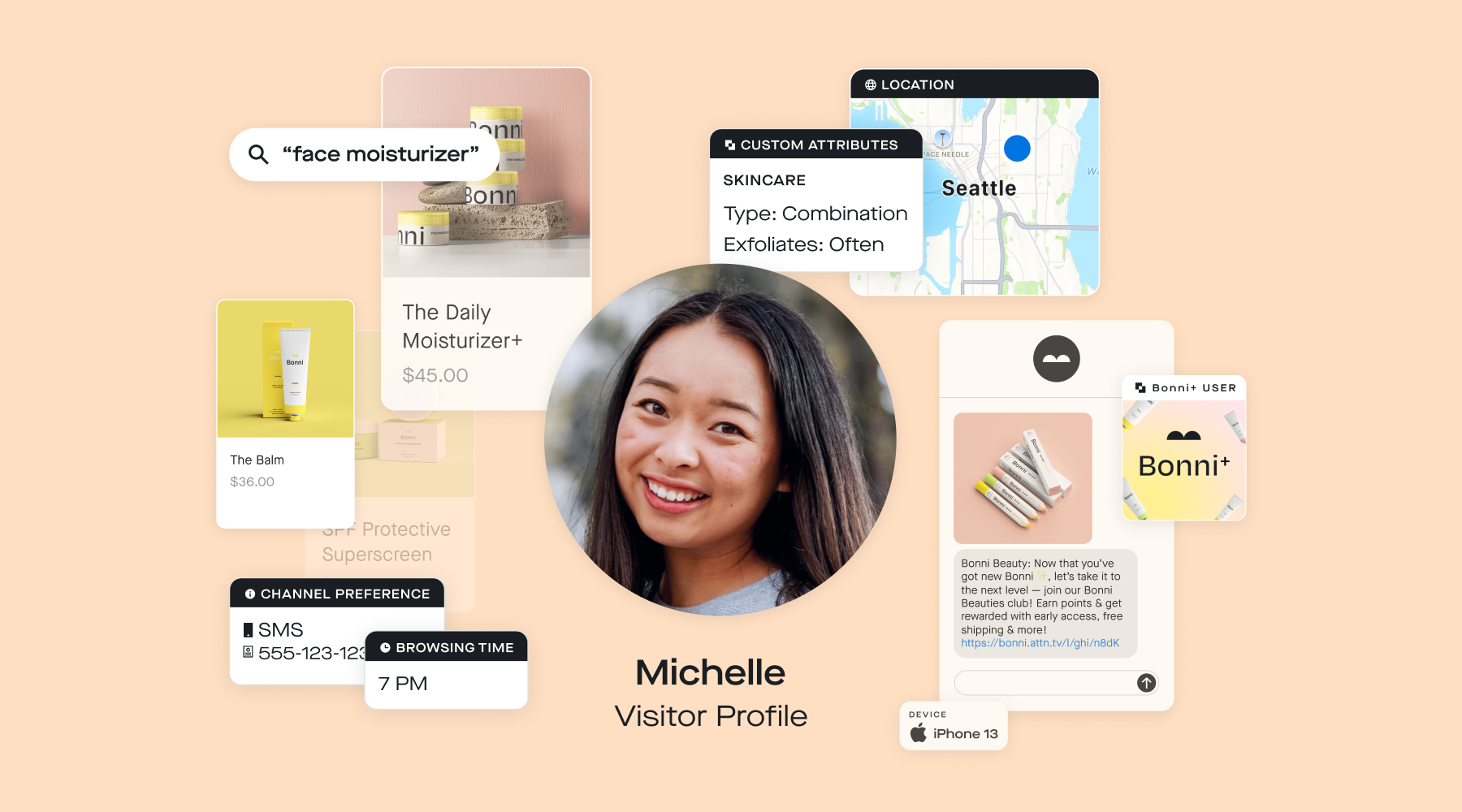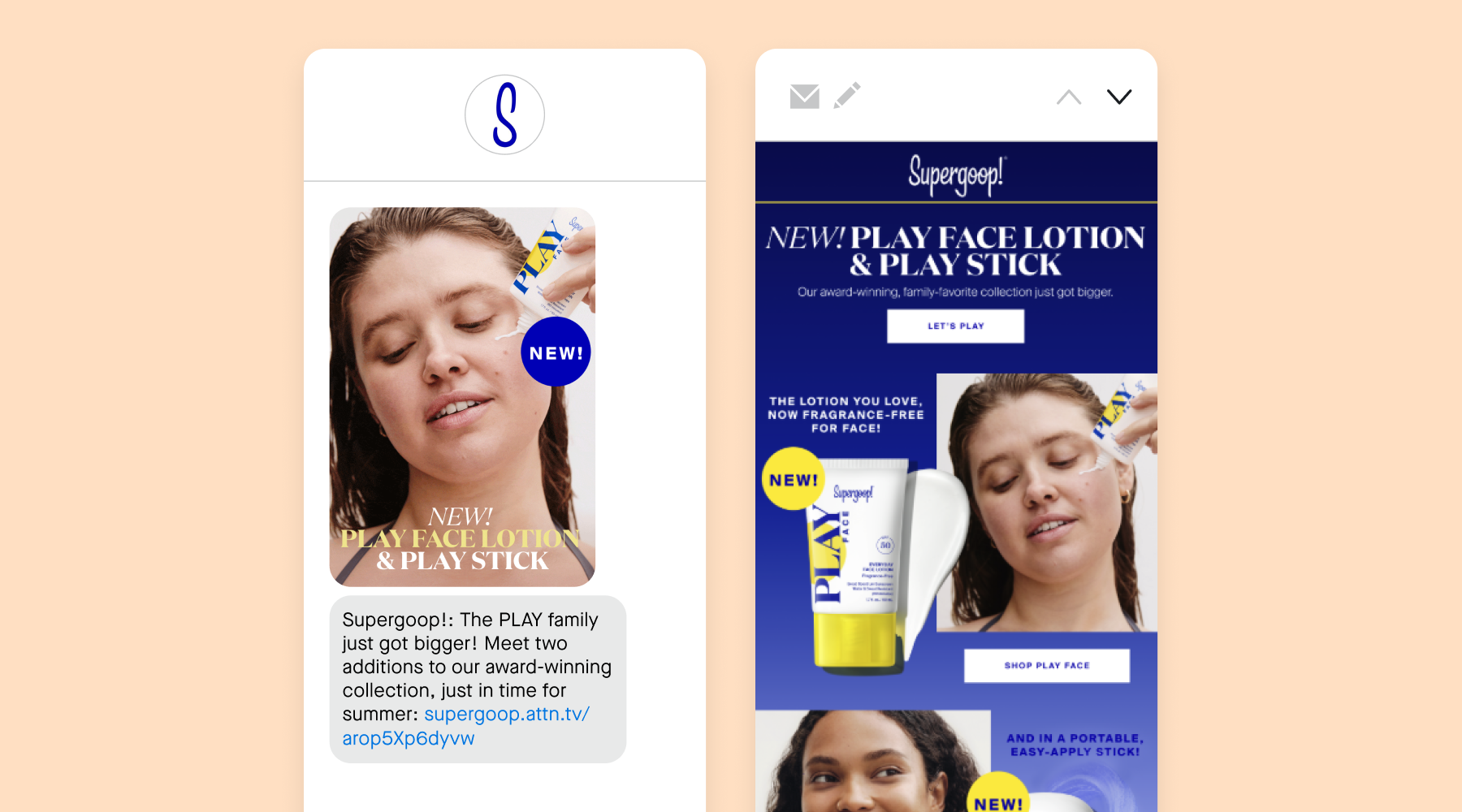
New releases
A smarter, simpler Attentive
Explore new features →
Explore new features →

Chances are, your audience is engaging with you on both email and SMS—our research shows that 85% of people who subscribe to a brand’s text messages also subscribe to their emails. And while they expect different experiences on each channel, there’s significant value in coordinated messaging.
When brands strategically orchestrate their SMS and email programs, they see better engagement and conversions. In fact, 58% of consumers say they’re more likely to make a purchase when receiving the same promotion on multiple channels—though 72% still want brands to use text and email differently.
This highlights an important opportunity: Instead of copy-pasting your strategy from one channel to the other, successful brands coordinate their email and SMS programs by unifying their data and thoughtfully leveraging the strengths of each channel to create a seamless customer experience. One where email and SMS fulfill complementary roles to drive higher conversion rates.
But it’s not easy if you lack the resources, bandwidth, and tools to do it well.
The right platform can make orchestration a breeze and transform your marketing effectiveness.
Here’s why bringing SMS and email marketing together on a unified platform is the future of exceptional customer experiences.
SMS and email marketing are most effective when combined strategically on a single platform, not treated as separate channels. A coordinated approach drives higher engagement, conversion rates, and customer lifetime value.
Read on to discover:
Orchestration is the purposeful coordination of marketing touchpoints across multiple channels. In this case, we're referring to the coordination of email and SMS marketing within a single strategy.
When done right, a multi-channel messaging strategy helps brands reduce costs by sending subscribers messages on the right channel at the right moment in the customer journey. This unified customer experience leads to better engagement, more revenue, and higher conversion rates. Ultimately, you boost the ROI of both channels.
Not everyone will want to subscribe to email. And not everyone will want to subscribe to SMS. But 85% of consumers say that when they subscribe to a brand’s SMS program, they also sign up for their email.
So figuring out how you’re going to speak to the customers who are subscribed to both is important for creating seamless customer relationships.
To unite SMS and email effectively, it’s helpful to understand the strengths of each channel. In general, SMS is best suited to quick or time-sensitive messages. Email lets you elaborate with more content and imagery.
SMS lets you reach shoppers in an app they’re already checking frequently. 82% of consumers check their texts within just five minutes of receiving a notification. So it’s the perfect medium for delivering messages customers will want to act quickly on, like:
Its short-form nature also lends itself well to communicating quick bites of information, like getting the word out about a product launch, sharing a quick tip, or highlighting a short customer review.
SMS also gives shoppers a direct line to communicate with your brand if you enable two-way texting. The conversational nature of the channel makes it easy for your customers to ask questions and get help fast—after all, 88% of consumers say they would text a brand to learn more about a product—increasing the chances of them converting from a text message.
Email marketing gives you more room compared to SMS. So you can go into detail about your offers, product features and benefits, company story, or anything else—in one message.
When we asked consumers which types of messages they want to receive by email in our 2025 Consumer Trends Report, they were more likely to want non-urgent content like:
While consumer preferences vary, this indicates a tendency towards enjoying visual and story-based content by email. This allows you to nurture customer relationships and build brand affinity.
The tradeoff with this channel is that people don't open emails as quickly. Only 23% of emails are opened within an hour of delivery. So the channel is ideal for content that’s not time-sensitive.
SMS and email each offer unique advantages for connecting with your audience. But their real power emerges when you strategically combine them.
When you bring SMS and email together on a unified platform, the channels complement each other to create a more effective marketing program.
The reality is—many of us have had dozens of email addresses over the years. Maybe we’ve even spun up new email accounts specifically for subscribing to marketing emails—as 1 in 5 shoppers have admitted to doing in our 2025 consumer survey of 3,300 consumers.
But often, people stick with the same cell phone number long-term. As a result, our phone numbers are more accurate identity markers. So marketers can build more complete and precise profiles for each customer by connecting their email and SMS programs together.
Then if a shopper gets a new email address, their data can be combined with their existing profile via their phone number. So you can continue to personalize your communications effectively, considering their entire history with your brand.
These comprehensive customer profiles create the foundation for true personalization, maintaining continuity throughout your relationship instead of treating each new email address as a new customer.

When your SMS and email programs operate on a unified platform, you create a more consistent and accurate view of each customer. Platforms like Attentive help brands maintain connections between channels, ensuring that subscriber activity is captured on your website and email and SMS channels and can be turned into personalization opportunities.
Bottom line: Unified subscriber data enables personalization that wouldn’t be possible with siloed channels. You'll be able to make better use of the first-party and zero-party data you collect on both channels to:
This leads to higher engagement and conversions for your whole program.
The fact that most shoppers are more likely to make a purchase when they receive the same promotion across channels, but want brands to use text and email differently points to an important nuance: Consumers are open to multiple communications about the same thing, but they want them to be part of one continuous story.
Imagine if a friend texted you about an upcoming event and then emailed you the exact same thing. You’d probably be confused as to why they’re sending you the same message in two places. It would make more sense if they told you the highlights by text: what and when, and then maybe forwarded you an email with the full event schedule.
It’s the same way with your email and SMS program. Send customers coordinated messages that adapt to each channel’s strengths.
With your data flowing seamlessly between email and SMS, you can create this kind of strategic orchestration by tailoring how you present information on each channel.
Take a product launch, for example. You can use text to announce the launch and drive instant traffic. Then use email to tell the full product story with more visuals, like suncare brand Supergoop! does in their recent product launch campaign:

Or for behavioral messages like a cart abandonment flow, start the journey with a text soon after a subscriber has left your site. That’ll help you recover more carts faster. Then, if they don’t check out, follow up with a more detailed email later that answers common objections to purchase.
Consumers interact differently with emails and text messages, so your marketing efforts need to be tailored to how your audience prefers to engage with each channel. With your data flowing seamlessly between email and SMS, you’ll be able to reach your customers when and where they’re most likely to click, browse, and buy.
Attentive has advanced orchestration to help brands execute this strategy for campaigns and triggered messages to maximize your impact.
When Supergoop! switched to Attentive Email to consolidate with their existing SMS program, they were able to more accurately identify subscribers and fine-tune their email strategy, achieving:
"Attentive Email delivers a highly efficient solution for message management. Its unified platform streamlines communication efforts, while providing advanced control over multi-channel content.” –Kim Nguyen, Senior Director, DTC & CRM, Supergoop!
When you combine email and SMS, you can reach more of your audience and increase brand exposure.
By using both channels, you establish more opportunities to connect with subscribers based on their individual preferences and behaviors. Some subscribers may check email more frequently during the day, and texts in the evening. Some might do the opposite.
Identifying these patterns lets you reach shoppers when and where they’re most likely to engage.
Since multi-channel messaging increases likelihood to purchase, it’s worth encouraging shoppers to subscribe to both. Not all shoppers will, but you can increase the chances by:

By extending your reach across multiple channels and tailoring your approach to subscriber engagement patterns, you maximize your opportunities to connect with your customers. So if someone misses a message on one channel, you’ve got another chance to engage on the other.
Our data shows that subscribers who receive both SMS and email are 2.4x more likely to buy than those who receive SMS alone.
This increased conversion power comes from the reinforcement effect that happens when subscribers see consistent messaging across channels.
A unified approach also brings efficiency gains, resulting in a higher ROI. With email and SMS on the same platform, you can:
L’Occitane demonstrates the power of this approach with their session abandonment journey. The brand sends a text to a subscriber 15 minutes after a website visit to quickly recapture their attention. An hour later, they follow up with a more detailed email if the subscriber still hasn’t returned to browse.
Since taking advantage of Attentive’s advanced orchestration capabilities, L’Occitane has achieved a 382% increase in conversions.

By strategically combining your email and SMS programs on a unified platform, you create a more efficient program, delivering improved conversion rates and a higher ROI while providing a better customer experience.
When your SMS and email programs operate together, you gain total customer visibility, enable strategic messaging that plays to each channel’s strengths, and drive higher conversion rates and ROI.
The platform you choose matters. Attentive provides the unified data foundation, advanced orchestration tools, and AI-powered personalization you need to create coordinated customer experiences across channels at scale.
Ready to magnify your impact on email and SMS? Get a demo to find out how Attentive can help you create exceptional customer experiences that drive real results.
SMS marketing delivers short, concise messages to subscribers that encourage immediate engagement. Email marketing allows for longer content with more visuals, rich formatting options, and multiple CTAs. SMS is best for urgent, time-sensitive communications, while email excels at more in-depth content.
Neither channel is universally "better"—they excel at different tasks. SMS is best used for time-sensitive messages and quick updates. Email allows you to send longer messages with more context. Our data shows that using both channels together is the most effective approach, with multi-channel subscribers being 2.4x more likely to purchase than those who receive SMS alone.
Start by unifying your data on a single email and SMS platform. Coordinate messaging by using each channel's strengths—SMS for short updates and email for comprehensive information. Give subscribers options to choose which content they receive on each channel, and segment your audience based on engagement patterns to optimize performance.